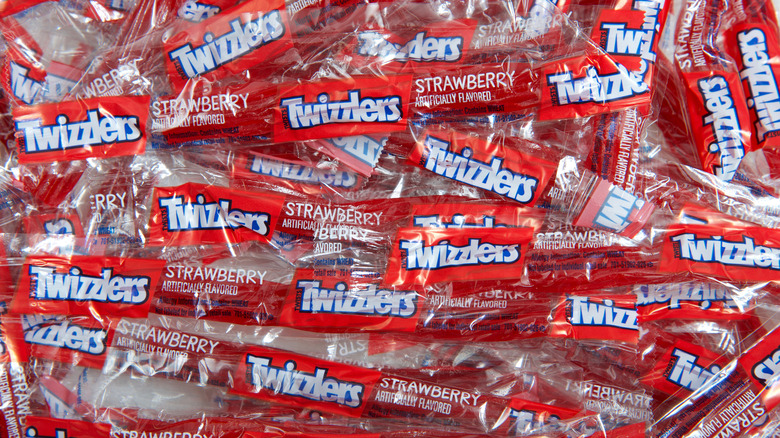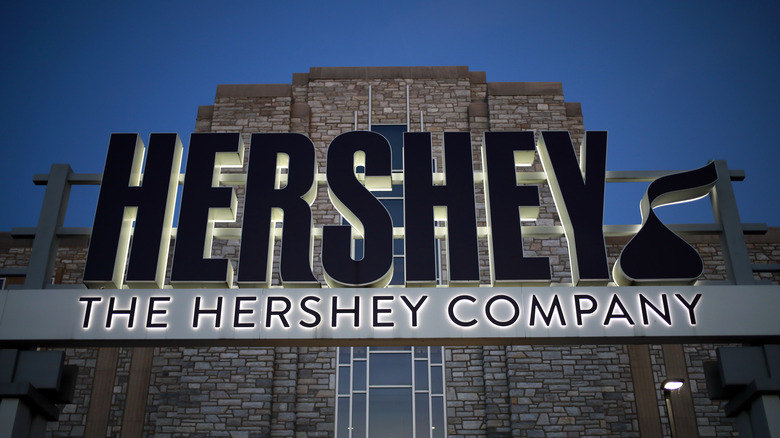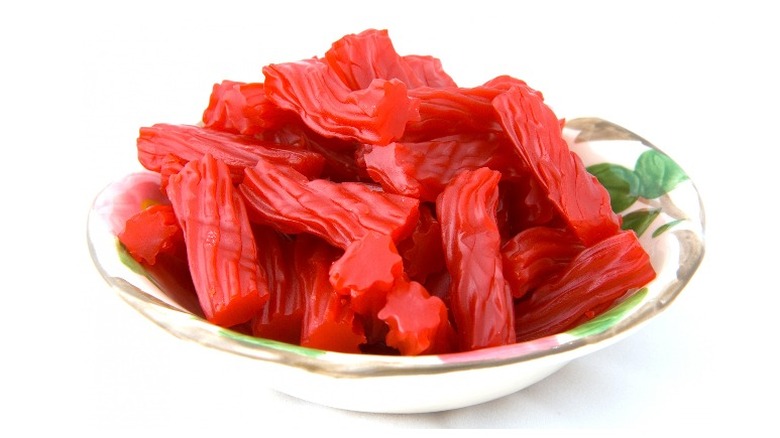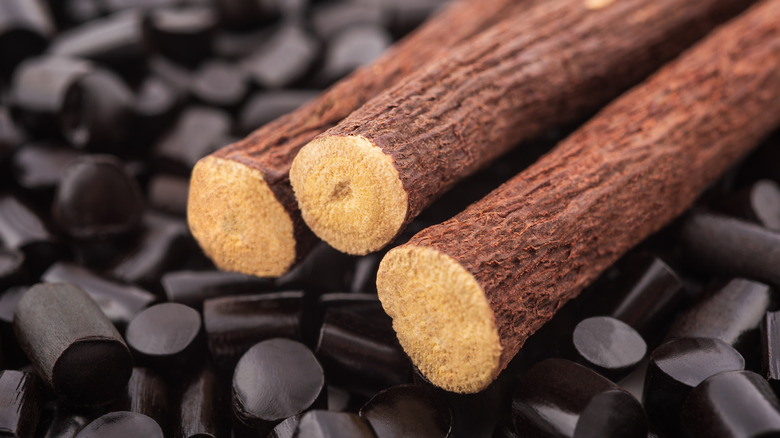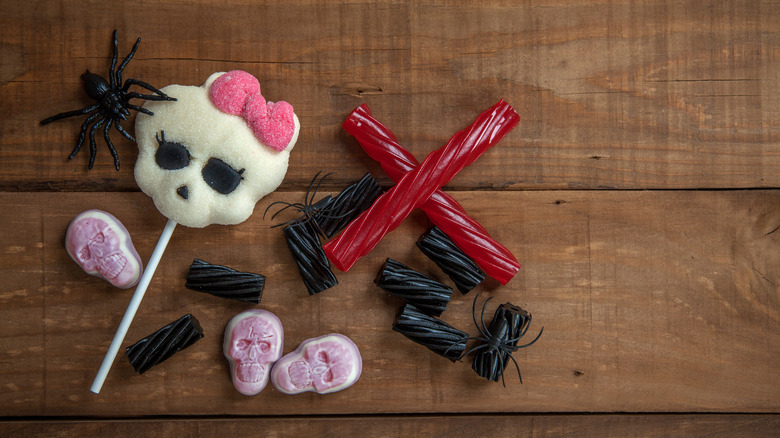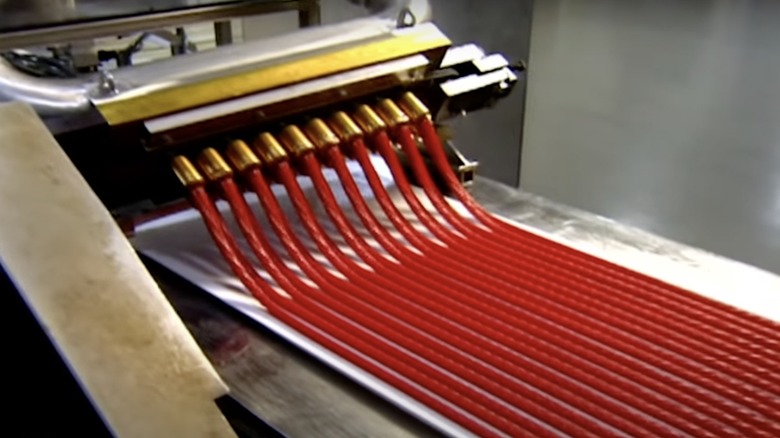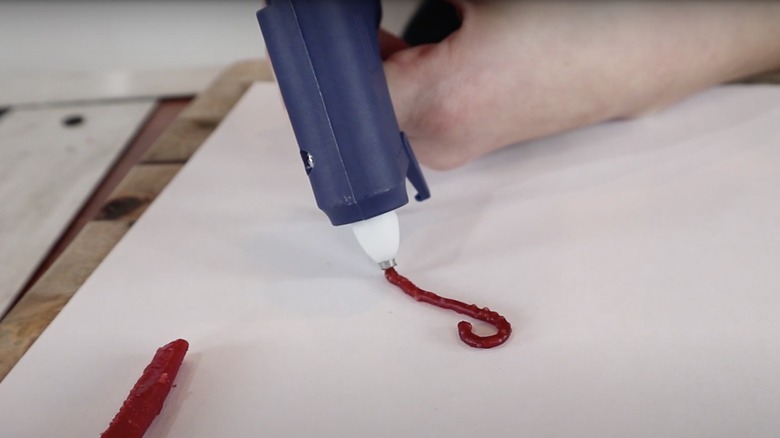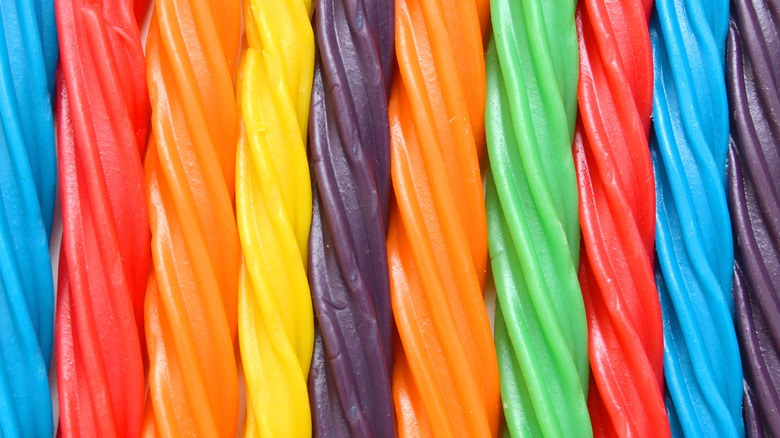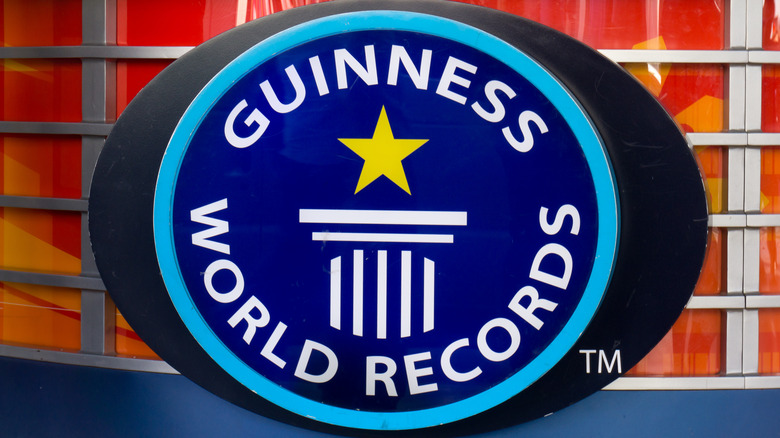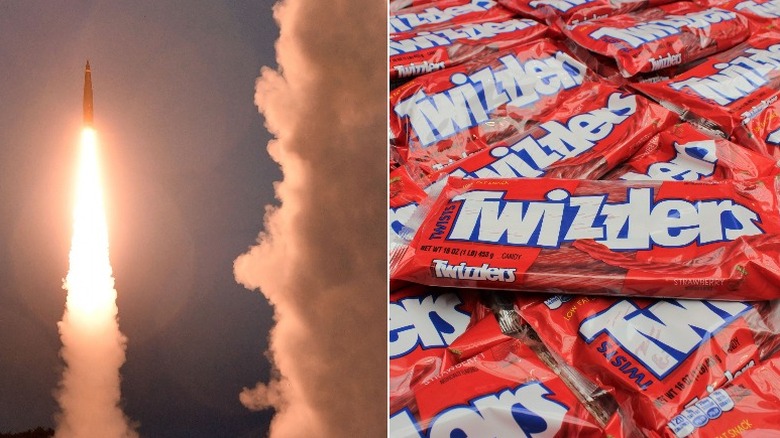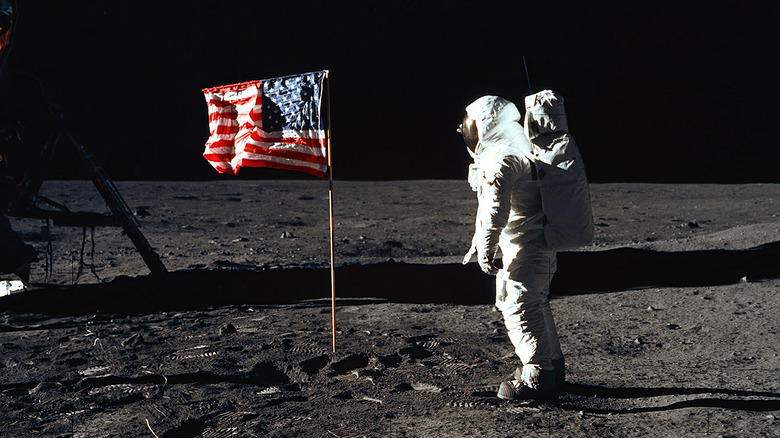The Untold Truth Of Twizzlers
We may receive a commission on purchases made from links.
Twizzlers are an iconic American snack and a movie theater favorite. In fact, these twisty ropes are the second-best-selling food at the movies, beaten only by popcorn. Twizzlers are also bestsellers outside of the theater: they're the most sold licorice-type candy and fourth-best-selling candy in general! Despite what Red Vines fans may argue, Twizzlers are the superior red licorice, and they have the stats to prove it. But that's an argument for another time...
Although they are extremely popular today, Twizzlers have a surprisingly long history, dating all the way back to 1845! In fact, the company that created them is one of the oldest candy producers in the US. In the nearly two centuries that followed, Twizzlers have gotten a ton of new flavors, upgraded their tech, had a part in political history, and even made fans out of some surprising contingents. Read on to find out some interesting facts about America's favorite licorice.
Twizzlers weren't created by Hershey
Although they are currently associated with the food giant, Twizzlers were not created by The Hershey Company. In fact, they weren't even acquired by Hershey until 1977. Young & Smylie is actually the company to thank for these classic favorites, although they did not have their iconic twist during their initial manufacture in 1845.
Young & Smiley were so well-known for their licorice that they incorporated, along with two other small companies, into the National Licorice Company in 1902. They continued producing several varieties of licorice under this umbrella, until one day in 1929, when the Twizzlers brand was born. These spiraled licorice sticks were an innovation, but they did not become popular until the 1960s, when the National Licorice Company changed its name to Y&S Candies Inc. in an attempt to appeal to more consumers.
Apparently, this change worked, and the Twizzlers brand's popularity soon caught the attention of The Hershey Company. In 1977, Hershey acquired Y&S Candies Inc., and by January of 1982 the companies had merged. Though much has changed for Twizzlers since their inception, the original Y&S factory in Lancaster, PA still produces licorice for the Twizzlers brand.
They haven't always looked like they do today
Twizzlers have always been spiraled licorice "whips," but they have undergone a series of changes over the years. For one, additional flavors were added to modernize the candy, such as chocolate, mint, and, of course, strawberry. New shapes were also added, like in 1994, when the Pull 'n' Peel came to stores. This shape allowed consumers to actually pull the Twizzler apart by its twists, adding a fun tactile element to the experience of eating the candy. They also launched Twerpz, the bite-sized twists with tangy fillings, and Strawz, which can actually function in drinks, in 2004. The most recent shape-innovation was 2020's Izzler, which is essentially a Twizzler without the twist.
The formula of the candy itself has also changed quite a bit. Historian Katharine Weber calls the modern Twizzler a "nearly plastic" version of the original, highlighting the textural changes that came with its new recipe. Although classic licorice is usually made of "licorice extract, sugar, a binder, starch or flour, gum arabic, flavoring, ammonium chloride, molasses, and gelatin," Twizzlers today are mainly composed of corn syrup, wheat flour, sugar, and cornstarch. The switch to corn-based products as opposed to sugar is what gives them a chewier, plasticky feel, as opposed to the bite and hardness of cooked-down granulated sugar.
Twizzlers aren't even really licorice
You may have noticed an absence of licorice extract in the Twizzlers ingredients list. Well, that's because most Twizzlers today don't actually contain any licorice — the only flavor with any licorice in it is the Black Licorice. Take a look at the Twizzlers packaging next time you get them. According to food expert Kelila Jaffe, Hershey purposefully does not include the word licorice on Twizzlers packets at all. "Instead," she tells HuffPost, "they are labeled as 'twists.'"
So, why do we even call red licorice "licorice" if it contains no licorice extract? Well, it hasn't always been this way. Many red licorice candies do actually contain licorice extract. So, why don't Twizzlers contain any? Maybe they were trying to market to a wider audience, or perhaps they were just trying to cut costs. Whatever the case, just don't expect to find any real licorice extract in those red Twizzlers you find in the candy aisle.
Eating too many Twizzlers might be dangerous
If you were starting to get disappointed by the lack of actual licorice in Twizzlers, consider it a blessing in disguise. Eating too much licorice can actually be detrimental to your health, and with the amount of red Twizzlers America eats, we could have an epidemic on our hands.
In 2019, a 54-year-old man died after consuming "one to two large bags of black licorice a day for three weeks." It turns out that one of the main components of licorice root, glycyrrhizic acid, can cause dangerously low potassium levels if ingested in high amounts. Symptoms of low potassium include "abnormal heart rhythms, high blood pressure, edema, lethargy, and congestive heart failure," which the man ultimately succumbed to. Although licorice has been used for medicinal purposes since ancient times, intake must be monitored to avoid potentially catastrophic effects.
In the wake of the man's death, four unrelated plaintiffs sued Hershey in 2021 over their licorice's dangerous effects. The plaintiffs claimed that Hershey's products containing licorice should come with a health warning and that not including one is an act of negligence.
They're surprisingly high-tech
The Twizzler brand may be old, but the machines used to make them are ultra-modern. Firstly, the patented nozzles that extrude the Twizzlers are highly engineered and use a secret mechanism to twirl the candy without ripping it. These nozzles produce on average 15 twists per Twizzler or two and a half full curves per inch. They also do it in seconds, whereas traditional licorice twists have to be hand-twirled in a much lengthier process.
Recently, Hershey has even incorporated artificial intelligence into its Twizzlers manufacturing. The AI helps standardize weights of individual Twizzler boxes, which were previously only estimates. The problem with estimates, no matter how close, is that they end up creating waste in the supply chain: filling a box with a smaller amount of food than the packaging lists is unlawful, so all estimates have to be made on the higher side. This means Hershey often stuffs more Twizzlers into boxes than are actually necessary. While this is pretty great for consumers (woohoo! An extra Twizzler!), it lowers profits for corporations. By using AI to monitor the weight of each licorice stick, Hershey reduces overfilled boxes and saves money.
They don't melt
If you're looking for a snack to keep in your pocket, look no further. Twizzlers apparently don't melt — or so the company claims. While Hershey has used this fact to market the candy during the summer months, curious consumers took it as an excuse to go to town on wacky experiments.
The team at Snack History includes a series of trials in their description of Twizzlers, including setting them on fire and sauteeing them on the stovetop. The fire, which came from a lighter, supposedly charred the Twizzlers rather than melting them. This created a "black and burned" whip that was "somewhat hard to the touch and crispy." The stovetop method achieved a similar outcome, resulting in a "dark and burned" Twizzler, albeit with some "bubbling" along the edges.
Other Twizzler fans have put their licorice in the microwave and even a hot glue gun. While the microwave yielded similar results to the stovetop and the lighter (the Twizzler became blackened and charred), the hot glue gun came as close to melting a Twizzler as you can get. As seen in their video, YouTuber The Gripsion is able to push slightly melted Twizzler out of a hot glue gun and make designs with it. However, the texture is nowhere near a liquid and is almost more softened than it is melted. The more you know!
There have been over 25 flavors
While the strawberry Twizzler flavor might be the most common, Hershey's has made over two dozen other Twizzlers flavors. From Hershey's chocolate to orange cream pop and sweet and sour, numerous flavors span the wide shape and size range of the Twizzlers lineup. The filled Twizzlers made for some great flavor combos, like caramel apple, key lime pie, and strawberry smoothie.
Their limited-edition holiday candies are usually Pull 'N' Peel varieties, which feature individually flavored and colored strands. The popular Fourth of July Pull 'N' Peel has red, white, and blue strands, which are lemonade, wildberry, and raspberry flavored. Another hit, the Holiday Pull 'N' Peel, has cherry, lemonade, and green apple flavors that swirl to look like a candy cane. They even released a mystery flavor in the classic twist shape in 2021, which was later revealed to be raspberry. If you'd like to do more digging, Snack History has compiled a pretty comprehensive list.
Twizzlers had a Guinness world record
Twizzlers entered the Guinness Book of World Records in 1998, and not even for their many, many twists. The record for the largest piece of licorice ever made was broken with a single giant Twizzler, which was 1,200 feet long and weighed 100 pounds! Although this sounds like a whole lot of licorice, it was nothing compared to the amount of candy Twizzlers produces in a single day: a whopping 200 tons (400,000 pounds). Still, the feat was certainly impressive, as it's way harder to make one big Twizzler than a bunch of little ones. The giant Twizzler was manufactured at the original Y&S Candies factory in Lancaster, PA, which was a lovely nod to the candy's inventors.
Unfortunately for The Hershey Company, this record has since been broken, and a Swedish town now holds the title. Their licorice string was 1,702 feet and nine inches long, far surpassing Hershey's record, but we'll let them have this one. Europeans eat more licorice, anyway.
They played an important role in a nuclear agreement with Iran
Thanks to a series of negotiations in 2015, Twizzlers now have a place in the American political canon. According to ABC News, the 15-person delegation responsible for negotiating with Iran over nuclear missiles sought out a comforting diet. While they were missing home, the delegates once ate "10 pounds of strawberry Twizzlers" in a single month, or two-thirds of a pound per person! In addition to Twizzlers, they consumed other classic treats in extreme amounts, including "30 pounds of mixed nuts and dried fruit, 20 pounds of string cheese, and more than 200 Rice Krispies treats."
And this wasn't the first time licorice featured prominently in a politician's diet. President Millard Fillmore supposedly kept a secret stash in the White House. Although he wasn't alive to see the invention of Twizzlers, he would certainly be proud of these munching delegates and their snack of choice.
Twizzlers have some surprising fans
Twizzlers have attracted some surprising fans beyond the normal candy-eating populations. For one, all sorts of athletes love them. Runner's World once featured Twizzlers in an article about marathons, saying their high sugar content is great for keeping up your carbs on long runs. Floyd Mayweather is also a big fan, and his personal chef revealed the twisted candy is an important part of his pre-match meals. Although they aren't athletes in the traditional sense, astronauts have to be in tip-top shape to go on expeditions, a fact which apparently makes them part of this Twizzler-prone contingent. In fact, Neil Armstrong is reported to have said "I could go for some Twizzlers right now" after landing on the moon (after he delivered his "one small step" line, of course).
Lastly, in 2015, a nationwide study by Hershey revealed that Utah eats nearly twice as much candy as any other state in the nation. Among their favorites were — you guessed it — Twizzlers, which were "especially popular in the Salt Lake City Area." Who knew?
